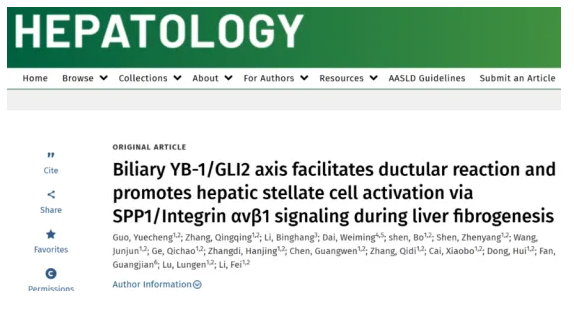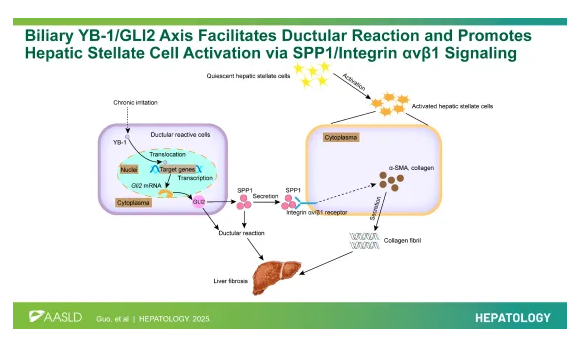- News
Scientific Research Update | Professor Lu Lungen's Team at Shanghai General Hospital Publishes New Findings in Hepatology on Mechanisms of Liver Fibrosis Prevention and Treatment Research Office
https://mp.weixin.qq.com/s/Sceaq4UHZ-JmZb9-hjyAUQ

Recently, the research team led by Professor Lu Lungen from the Department of Gastroenterology, Shanghai General Hospital, published an article entitled “Biliary YB-1/GLI2 axis facilitates ductular reaction and promotes hepatic stellate cell activation via SPP1/Integrin αvβ1 signaling during liver fibrogenesis” in Hepatology (Impact Factor: 15.8), a leading international journal in the field of hepatology. The study reveals a novel mechanism of cellular interaction between ductular reaction cells (DRCs) and hepatic stellate cells (HSCs) in promoting liver fibrosis progression, providing new theoretical insights for the prevention and treatment of liver fibrosis.

Liver fibrosis represents a reversible repair response of the liver to chronic injury, reflecting a dynamic balance between tissue repair and scar formation. HSCs are the principal source of extracellular matrix during fibrosis, and their activation and proliferation constitute the central process of fibrogenesis. Previous studies have suggested that DRCs, as key participants in hepatic repair following chronic liver injury, are closely associated with the onset and progression of fibrosis. Professor Lu’s team previously observed significant ductular proliferation and ductular reaction in the portal areas of patients with chronic hepatitis B and nonalcoholic steatohepatitis, accompanied by HSC proliferation and extracellular matrix deposition, suggesting that excessive DRC proliferation may exacerbate inflammation and drive HSC activation.
The current study demonstrated that Y-box binding protein 1 (YB-1) is highly expressed in DRCs of patients with chronic liver disease and in mouse models of liver injury. Conditional knockout of YB-1 significantly reduced ductular reaction, hepatic inflammation, and fibrosis in these models. Mechanistic investigations revealed that YB-1 transcriptionally regulates GLI2 expression, thereby promoting DRC proliferation. Proteomic and bioinformatics analyses further identified osteopontin (SPP1) as a key mediator linking DRC proliferation to HSC activation via YB-1/GLI2 signaling. SPP1 was found to be upregulated in injured human livers and shown to interact with integrin αvβ1 receptors. Moreover, deletion of YB-1 inhibited SPP1 secretion from DRCs, while blockade of integrin αvβ1 receptors in HSCs effectively suppressed SPP1-induced HSC activation.
Taken together, these findings indicate that the YB-1/GLI2 axis drives DRC proliferation and SPP1 secretion, which in turn promotes HSC activation through integrin αvβ1 signaling, thereby advancing hepatic fibrogenesis. This suggests that the YB-1/GLI2/SPP1 pathway may represent a potential therapeutic target for liver fibrosis.
The corresponding authors of this study are Dr. Fei Li and Professor Lu Lungen' from the Department of Gastroenterology, and Dr. Guang-jian Fan from the Center for Precision Research in Intractable Diseases, Shanghai General Hospital. Co-first authors include Dr. Yue-cheng Guo and Dr. Qing-qing Zhang from Shanghai General Hospital, and Dr. Bing-hang Li from Huadong Hospital affiliated to Fudan University. This research represents a continuation of Professor Lu’s long-term efforts in clinical and basic studies on liver fibrosis and was supported by the National Natural Science Foundation of China, the Shanghai Municipal Science and Technology Commission, and other funding programs.
